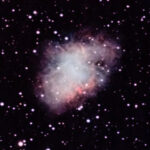A fair question that I am sometimes asked is about why I prefer astronomical imaging aspects over visual observing. The answer, it turns out, is that imaging instead of observing at the eyepiece is a practical matter that is well aligned with my interests.
As for the practical matter, especially for faint deep-space objects, I beneath the bright Balitmore-Washington light dome. On the Bortle scale, my backyard is class 6 sky. This means that without considerable effort to pack up gear and drive a long way, my visual pursuits would be repeated visits to the same few targets. I bore quickly, so this is not a sustainable condition for me. Although imaging at home is not optimal, I have access to many more targets, and I can practice my craft so that I can be more productive and collect better data on the those occasions when I am able to get away to a dark site.
The alignment of imaging with my interests is interesting in and of itself. Looking back at my working years, I can see that maybe I should have been an engineer. One of the things that I enjoy most about imaging is taking disparate technnology hardare and software components and integrating them into an astronmical imaging system that produces high-quality images. I find this to be hugely challengeing, and very rewarding to work these things out.
Even at dark sites, there is another light source that requires consideration – the Moon. For this reason, dark site trips and regional star parties are scheduled within a few days before or after the New Moon.
In addition to preparing for dark-sky trips, I can easily do solar system imaging from my back yard. The Sun, Moon, and major planets require are bright and small, and require different imaging techniques than those used of deep space targets. Because these targets are so bright, light pollution or bright moonlight are not a problem for planetary imaging.
Getting to a dark clear sky is only half of the fun for me. I also enjoy producing images from the data that I capture. This, too, can be a big challenge. Knowledge of sensors and the data they produce is a starting point for making images. Also, having the knowledge to select the right tools and methods are also critical.
Another practical matter is that imagery helps me share my astronomy. While I do enjoy sharing views at the eyepiece, attracting interested viewers and being lucky enough to have clear skies for a planned event is a significant constraint. With my imagery, which is available on Flickr, my astronomy over the past few years is available all the time.
And finally, not only do I enjoy making the pretty pictures and sharing them, I enjoy looking at them too.
I think of planetary imaging and DSO imaging as two sides of the same coin, and I enjoy both. As there are times during the lunar cycle and there are times when atmospheric conditions favor one over the other, I simply choose which ever is the most appropriate for any given observing opportunity.
© James R. Johnson, 2022.jim@jrjohnson.et

